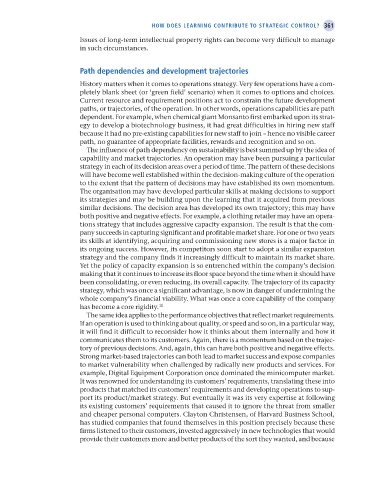Page 386 - Operations Strategy
P. 386
hoW does learnIng ConTrIbuTe To sTraTegIC ConTrol? 361
Issues of long-term intellectual property rights can become very difficult to manage
in such circumstances.
path dependencies and development trajectories
History matters when it comes to operations strategy. Very few operations have a com-
pletely blank sheet (or ‘green field’ scenario) when it comes to options and choices.
Current resource and requirement positions act to constrain the future development
paths, or trajectories, of the operation. In other words, operations capabilities are path
dependent. For example, when chemical giant Monsanto first embarked upon its strat-
egy to develop a biotechnology business, it had great difficulties in hiring new staff
because it had no pre-existing capabilities for new staff to join – hence no visible career
path, no guarantee of appropriate facilities, rewards and recognition and so on.
The influence of path dependency on sustainability is best summed up by the idea of
capability and market trajectories. An operation may have been pursuing a particular
strategy in each of its decision areas over a period of time. The pattern of these decisions
will have become well established within the decision-making culture of the operation
to the extent that the pattern of decisions may have established its own momentum.
The organisation may have developed particular skills at making decisions to support
its strategies and may be building upon the learning that it acquired from previous
similar decisions. The decision area has developed its own trajectory; this may have
both positive and negative effects. For example, a clothing retailer may have an opera-
tions strategy that includes aggressive capacity expansion. The result is that the com-
pany succeeds in capturing significant and profitable market share. For one or two years
its skills at identifying, acquiring and commissioning new stores is a major factor in
its ongoing success. However, its competitors soon start to adopt a similar expansion
strategy and the company finds it increasingly difficult to maintain its market share.
Yet the policy of capacity expansion is so entrenched within the company’s decision
making that it continues to increase its floor space beyond the time when it should have
been consolidating, or even reducing, its overall capacity. The trajectory of its capacity
strategy, which was once a significant advantage, is now in danger of undermining the
whole company’s financial viability. What was once a core capability of the company
has become a core rigidity. 11
The same idea applies to the performance objectives that reflect market requirements.
If an operation is used to thinking about quality, or speed and so on, in a particular way,
it will find it difficult to reconsider how it thinks about them internally and how it
communicates them to its customers. Again, there is a momentum based on the trajec-
tory of previous decisions. And, again, this can have both positive and negative effects.
Strong market-based trajectories can both lead to market success and expose companies
to market vulnerability when challenged by radically new products and services. For
example, Digital Equipment Corporation once dominated the minicomputer market.
It was renowned for understanding its customers’ requirements, translating these into
products that matched its customers’ requirements and developing operations to sup-
port its product/market strategy. But eventually it was its very expertise at following
its existing customers’ requirements that caused it to ignore the threat from smaller
and cheaper personal computers. Clayton Christensen, of Harvard Business School,
has studied companies that found themselves in this position precisely because these
firms listened to their customers, invested aggressively in new technologies that would
provide their customers more and better products of the sort they wanted, and because
M10 Operations Strategy 62492.indd 361 02/03/2017 13:28

